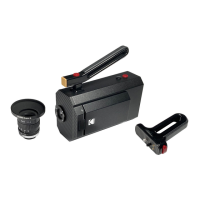22
1. Gently push in the SD card to eject it.
2. Transfer audio iles from the SD card to your computer.
You can synchronize audio with your digital scans using
your preferred video editor, such as Final Cut, Premiere,
Vegas, etc.
Getting Started
Transfer Audio Files: SD card
Audio File Management
The digital audio recorded iles are saved in .wav format in a
speciic folder on the SD card.
For every new cartridge, the system generates a new
cartridge number folder. The cartridge number assigned
by the camera is incremental, starting with default of (1)
when the camera is turned on and a cartridge is inserted
for the irst time. Audio iles in the folder are named in the
following manner for ease of post-processing. (Example:
C0001S0001F0001 where C0001 = Cartridge number,
S0001 = Scene number, and F0001 = Frame number).
Within the folder the Audio iles are stacked with the latest
Audio ile on top of the stack.
Audio recording is allowed only when shooting at 24fps or
25fps and audio input devices are connected and selected.
Every start/stop of the RUN button will generate a separate
Audio .wav ile, provided the Audio ile recording conditions
are met.
To work with the sound iles, the SD card should be insert-
ed in a computer to move or copy the iles from the SD
card.
NOTE:
• Do not rename the ile names on the SD card. Please
keep the original ile naming and ile structure to avoid
any conlicts in the camera Audio log iles when the SD
card is inserted again into the camera.
• You may rename the folders or iles only on the external
computer or storage device. But not on the SD card used
in the camera.

